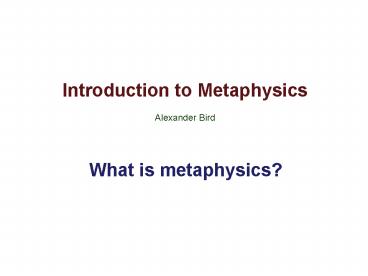Introduction to Metaphysics - PowerPoint PPT Presentation
1 / 20
Title:
Introduction to Metaphysics
Description:
is the study of the most general features of our world. what is ... a tennis racket? my family? abstract objects numbers and sets? which complex objects exist? ... – PowerPoint PPT presentation
Number of Views:1699
Avg rating:3.0/5.0
Title: Introduction to Metaphysics
1
Introduction to Metaphysics Alexander Bird
What is metaphysics?
2
my webpage eis.bris.ac.uk/plajb/
3
metaphysics is the study of the most general
features of our world
what is required in order to give a complete
description of the world?
an inventory of the worlds entities an
account of how they combine
4
1. The world is everything that is the case. 1.1
The world is the totality of facts, not of
things. Tractatus Logico-Philosophicus
5
Introduction to Metaphysics
What are things?
6
what kinds of objects exist?
simple objects fundamental particles?
space-time points? complex objects an atom? a
tennis racket? my family? abstract objects
numbers and sets?
7
which complex objects exist?
mereology the theory of the relation between
parts and wholes
8
which complex objects exist?
unrestricted mereological composition for any
objects, a, b, there is a further object a
b (the fusion of a and b) of which a, b are
parts
9
unrestricted mereological composition
can items separated widely in space and time form
a whole? (families? nations? species?)
10
unrestricted mereological composition
the fusion of a and b necessarily has a and b as
parts but most objects can lose some parts and
continue to exist
11
how many objects?
seemingly one table but how many parts?
12
(No Transcript)
13
(No Transcript)
14
count under a sortal
how many tables? (not how many objects?
15
how many mountains where Everest is?
16
(No Transcript)
17
many mountains? (which one is Everest?) or one
mountain? (which is its boundary?)
18
could there be just one mountain which is a vague
object?
19
vagueness
- there is a precise boundary, but we can never
know which it is (epistemicism) - there is no precise boundarythe objects is
itself vague (ontic vagueness)
20
Evans problem for ontic vagueness
ontic vagueness requires vague identity
a and b are vaguely identical but a and a are
precisely (definitely) identical, not vaguely
identical Thus a and b have different
properties hence a and b are (precisely)
non-identical.

